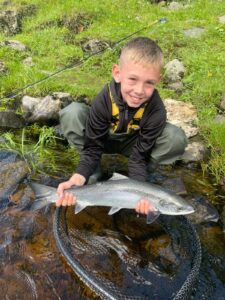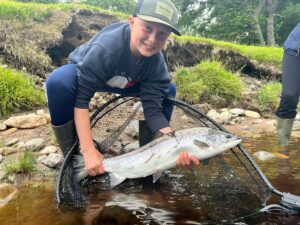The River Spey is a designated Special Area of Conservation for a range of species, including Scotland’s iconic wild Atlantic salmon – a species under threat, which is considered by many to be in crisis. The Spey Fishery Board (SFB) is calling for a reduction in the volumes of water artificially diverted from the river’s catchment to generate hydro-electricity and the re-watering of some of the Spey’s tributaries. This follows the publication of an independent report, produced for the SFB by EnviroCentre Ltd, on the extent of water abstractions and transfers from the Spey and their impact on the groundwater stored within the riverbed. This report confirms that the Spey is one of the most heavily-abstracted major rivers in Scotland and a copy of the full Report can be found here.
The Report shows that of all the water permitted to be abstracted or diverted out of the catchment, over 90% of it is taken from the top 13% of the Spey catchment, then diverted either to Fort William, or to the Tay to generate hydro-electricity. In place since the 1940’s, these schemes can reduce the natural flow in the Spey by up to 24% at Boat o’ Brig, near Fochabers, and by up to a massive 61% at Kingussie.
Crucially, the Report highlights that the Spey valley has extensive sand and gravel deposits that now store far less water than would naturally be expected, due to the lower river levels as a result of these diversions. This loss of water storage capacity is exacerbated by historic land use practices and reduced snow melt in the spring. The net result of this reduction in natural flow is that it has reduced the resilience of the river to cope with the low flow conditions and higher water temperatures we are experiencing more and more as a result of climate change. Many people on Speyside will recall the dramatic drop in water levels in Loch Vaa near Aviemore, which is fed by groundwater, during the exceptionally dry summer of 2018. This is an excellent demonstration of the reduced resilience the River Spey now has to the dramatic fluctuations in climate.
The SFB is working to redress this by promoting a programme of ecosystem restoration. For example, if the flow was reinstated to the Allt Sluie near the top of the Spey catchment at Dalwhinnie, this would off-set the amount of water abstracted at the Dipple wellfield on the lower Spey near Fochabers. Crucially, though, it would provide benefits downstream throughout the entire river. Other opportunities include: the restoration of the River Mashie near Laggan, most of the flow from which is diverted to Fort William; and the re-instatement of flows down the Allt Bhran and down the River Cuaich, both of which are currently diverted into the Tay system.
The SFB is now approaching the Scottish Government and Scottish Environment Protection Agency to support and encourage these river restoration opportunities. These would provide nature-based solutions to increase groundwater storage, which in turn will help top-up the river during periods of drought. In so doing, it will help make the Spey more resilient to the huge challenges we all face now and in the future with regard to the climate emergency.





